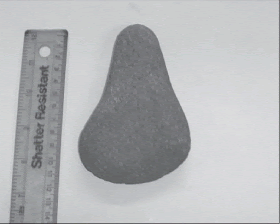New perspectives on the Agordat material, Eritrea: A re-examination of the archaeological
material in the National Museum, Khartoum
Agordat in Eritrea has provided one of the most extensive pre-historic materials in the Horn of Africa. The materials were collected and presented to the Sudan National Museum by A. J. Arkell and Major J. S. Last, the political governor of Eritrea in 1942
في أغوردات في إريتريا تم العثورعلى واحدة اقدم اثار ومواد ما قبل التاريخ في القرن الافريقى تم جمع المواد وعرضها في المتحف القومي السوداني من قبل أركيل و ماجور الذي كان آخر حاكم السياسي لإريتريا في عام 1942. معظم من المواد المستخرجة من سطح الموقع من أربع مناطق مختلفة في ضواحي أغوردات: جبل كوكان، نتاني، شابيت، وداندانيت. وقد وجدت اكثر المواد في كوكان وتشمل القطع الأثرية ، شظايا هيكل عظمي الإنسان والأسنان، وادوات اثرية صورها ملحقة، آركل (1954) يرى أن الاكتشافات موحدة تماما ويعتبر انهم ينتمون إلى ثقافة واحدة. التحليل الجديد من المواد يدل على أن المواد هي متنوعة جدا ومع ذلك، يظهر الاتصال الرئيسي، كما اقترح أركيل، أن تكون ذات صلة بثقافات وادي النيل ويرجع تاريخها إلى حوالي الألفية الرابعة
Agordat material, Eritrea, implication on Early Food Production
Early Food Production & Regional Contact
By Alemseged Beldados, 2012
Based on M.A. thesis at the University of Bergen.
Agordat in Eritrea has
provided one of the most extensive pre-historic materials in the Horn of Africa.
This thesis is primarily based on the analysis of archeological materials from
Agordat and comparing this with contemporary sites in the Sudan.
The thesis is primarily based on the analysis of
archeological materials from Agordat, Eritrea and is comparing this with
contemporary sites in the Sudan. It is structured into five chapters. Chapter
I deals with the history of research and the culture history of
Agordat and its environs. Under the topic the history of research, a
summary of the researches done on the economic prehistory of the Horn of Africa
is given. The summary is done with the intention of drawing an image on the
paucity of prehistoric research in the Horn of Africa and to show the
contribution of the Agordat material in filling up the gap required for a
better understanding of the period. The main manifestations of the
archeological groups and the description of the sites in the eastern desert and
along the Nile Valley of the Sudan that are contemporary with Agordat is dealt
in detail under the culture history of Agordat and its environs.
Chapter II
describes the study area and the palaeo-environment of the study area. A
brief overview is made on how climatic fluctuations influenced the settlement
of people in this area under the title palaeo-environment and human settlement.
A synopsis of the pottery classification and the
stone tools from Agordat is presented in Chapter III. A detail
description for each of the pot shreds (n=1469) in accordance with their
inventory number is presented in the appendix of this part of the thesis. The
analysis of the pottery from Agordat is followed by a comparison of the main
features (dominantly based on decoration patterns) with some other co-existing
sites.
Chapter IV
discusses the prehistoric exchange trade that the Horn of Africa had with the
Nile valley of the Sudan and Egypt. Obsidian (hard, dark glass like volcanic
rock), cowry shells (highly polished, usually brightly colored shell of a
marine gastropod used as money or ornament in certain parts of Asia and
Africa), and incense were dealt as items of exchange. The influence of trade
for the evolution of some archeological groups in Lower Nubia is also
presented. This chapter shows how easily ideas can flow from one cultural group
to the other though medium of exchange trade.
The result of the analysis of plant impressions on
pot shreds from Agordat is dealt in Chapter V. This chapter gives a
general view of the types of plant recovered in relation to recent
archaeobotanical works in the nearby regions. The last part of this thesis
synthesizes the five chapters and gives a concluding remark.
---------------------------------------------------------------
The article can be downloaded at:
http://www.mediafire.com/file/vdmsa5nezly49to/Agordat+material+2007.pdf
The full article: Arkell, A.J. 1954. Four occupation sites at Agordat. Kush, 2: 33 – 62
http://www.mediafire.com/file/jmcc12a79be934t/Agordat+occupation+sites+arkell+1954.pdf
OR can be accessed here: http://sfdas.com/IMG/pdf/kush_ii.pdf
-----------------------
Thanks to Mahmoud Lobinet for the links
------------------------------------------------
Another related article:
From the sea to the deserts and back: New research in Eastern Sudan and Eritrean lowlands
https://unora.unior.it/retrieve/handle/11574/40503/30413/Manzo_BMSEAS_18_2012_light.pdf
To sum up, all of these elements may point to intense contact between the Eritrean-Sudanese lowlands and Upper Nubia and suggest that, as expected, the south-easternmost region of the Kerma cultural area, i.e., the Fourth Cataract region, played an important part in this interaction. These remarks also suggest that the Eritrean-Sudanese lowlands had contact with the Red Sea coast and the Eastern Desert and may have had direct contact with Lower Nubia via the Eastern Desert, Arabia and perhaps Egypt via the Red Sea. It should be stressed that the processes of interaction between Nubia and Eastern Sudan led not only to the exchange of goods but also to the local production in Eastern Sudan of recorded in Gash Group and Jebel Mokram Group assemblages, described.
----------------------------------------





No comments:
Post a Comment